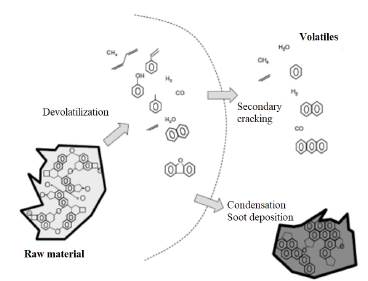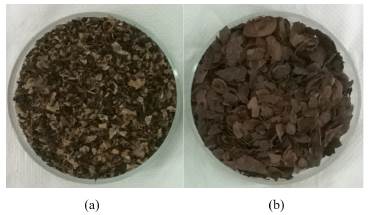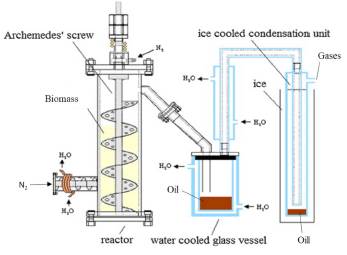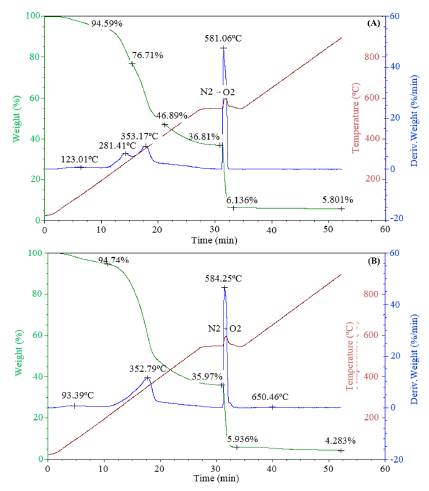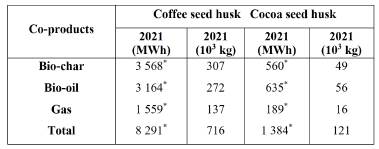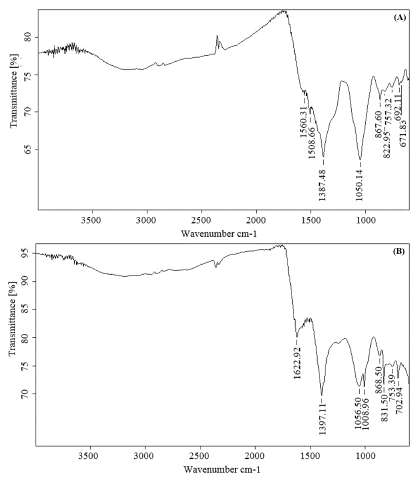Introduction
Sustainable development is the key to assure the quality of life for future generations by decreasing the environmental contamination. Since the global energy crisis in 1970, considerable efforts have been made to find alternative fuels [1]. Sustainable energy from biomass is considered to be carbon cycle neutral with no net increase of CO2 levels in the atmosphere because the CO2 released during their burning is fixed in the biomass by photosynthesis [2]. The production of biomass fuels from agricultural waste decrease waste disposal into the environment by transforming it into added value products [3-5].
Pyrolysis is the thermochemical decomposition of organic materials in an inert atmosphere, at temperatures between 400-900 °C [6, 7]. This process produces bio-char (~18 MJ/kg), bio-oil (~17 MJ/kg), both being considered as a medium to high-energy-density materials, and gaseous low energy-density products (~6 MJ/kg)[8]. The gas can be employed for cooking or burned directly as fuel for power production [9], and the bio-oil is used as chemical feedstock for valuable chemical substances, this last product needs to be upgraded due to its high water and complex oxygenated hydrocarbon contents [10].
Slow pyrolysis is based on the partial combustion of the biomass by uniform and slow heating rates (~ 10-15 °C/min), at temperatures between 400 and 650 °C in the absence of oxygen. Pyrolysis involves mass and heat transfer phenomena, as well as chemical reactions. The chemical reactions during pyrolysis can be linked with three different phenomena. First, the biomass devolatilization: solid decomposition into gas, oil, and solid residue (bio-char), then secondary reactions between the species in released gas and oil fractions and finally, heterogeneous reactions between gas and solid [11]. Figure 1 depicts a typical reaction scheme of the bio-char formation during carbonization [6]. Slow pyrolysis with lower temperatures (around 400 °C) tends to produce more bio-char [12]. Bio-char is a carbon-rich solid product defined as a long-term carbon storage material [13].
During pyrolysis, most of the Ca, Mg, K, P, biomass micronutrients, and about half of the N and S in the raw material (biomass) are concentrated into the bio-char fraction, allowing for their use as soil amendment. The use of bio-char as soil amendment can improve the nutrient availability [12, 14-16] and thebio-adsorbent properties towards herbicides and metals [17], thus increasing crop yields and organic compensation [18, 19]. Agricultural by-products and lignocellulosic materials have proved to be promising raw materials to produce bio-chars because of their high availability and low price. The use of agro-wastes can contribute to the economic development and to reduce the environmental contamination particularly in developing countries [18, 20].
For 2021, Cuba pretends to triplicate the crops of coffee and cocoa, with the increase in biomass waste. The eastern region of Cuba concentrates 92% (w/w) of coffee and almost 100% (w/w) of cocoa crops, most of them in mountains and isolated regions where the use of coal from woody biomass is a very usual cooking technique [21]. The pyrolysis of coffee and cocoa seed husks provides renewable energy and improves both the soil and the agricultural efficiency simultaneously.
The present work evaluates the yield and the theoretical energy potential of co-products (bio-char, bio-oil and gas) from coffee and cocoa seed husks pyrolysis process made in an electric lab-scale reactor to determine the potential contribution of these agro-wastes to the economic development and to reduce the environmental pollutions of the eastern region of Cuba caused by these. At the same time, we made a characterization of biomass and the pyrolysis process.
Materials and methods
Raw materials
Coffee and cocoa seed husks were acquired from the eastern region of Cuba. Coffee husks were collected from six coffee-grain processing plants located in II Frente and Nipe-Sagua-Baracoa mountains (around 500 g from each one). For cocoa seed husks 6 samples (around 500 g each) were collected from Baracoa chocolate enterprise in a normal operational day. Each sample was collected with a separation of 15 days between them. For obtaining homogeneous and representative samples of coffee and cocoa seed husks, the samples were homogenized using the quartering method with cone and ring in correspondence with AASHTO T 248, until a final amount of 1000 g of each material was obtained. The samples of coffee and cocoa seed husks are presented in Figure 2.
Biomass characterization and pyrolysis process
Coffee and cocoa seed husks represent around 12% of the dry fruit weight [23, 24]. The biomass composition (hemicellulose, cellulose, and lignin) of coffee and cocoa seed husks was determined by an adapted Van Soest and Wine gravimetrical method [22]. As the extractives (waxes, fats, resins, tannins, gums, sugars, starches, and pigments) can interfere with the Van Soest and Wine gravimetrical method, the samples were first subjected to ethanol extraction. The analyses were performed in triplicate.
Samples were characterized by thermogravimetric analysis with the first derivative of the TGA curve (TGA-DTG) to obtain information about the thermal degradation behaviour of coffee and cocoa seed husks using a TGA Model 950200, DuPont Company, USA, instrument device to select the best temperature for pyrolysis process.
Sample (~10 mg) was weighed into a quartz crucible and heated with a heating rate of 10 °C/min from room temperature to 600 °C under N2 atmosphere. At 600 °C the gas flow was switched to O2 atmosphere and the sample was heated until 900 °C at the same heating rate.
The bio-chars were prepared from coffee and cocoa seed husks biomass. Samples were first pyrolyzed in an oxygen-free atmosphere in an electric lab-scale reactor [25]. For each experiment, 0.3 kg of sample was introduced into the reactor (Figure 3). After the reactor was sealed and placed under a stream of nitrogen (2 x 70 mL/min), it was then heated with a rate of 10 °C/min up to 450 °C and then held for an isothermal period of 60 min to complete the pyrolysis process. The sample was continuously kept in motion by an Archimedes screw to achieve a uniform heat distribution. The reactor was heated up with a special tailored heating mantle, and temperature was checked with a thermocouple located inside the reactor [25]. During the thermal treatment, sample was subjected to thermal cracking and volatilization. The gases formed left the reactor and passed through a condensation unit. The condensed fraction was pyrolytic oil. The formed bio-char remained behind in the reactor and the non-condensable gases left the system (Figure 3). Coffee and cocoa seed husks bio-chars were coded as H-CHAR and C-CHAR, respectively.
The yield, Y (% w/w), of bio-oil and bio-char was calculated using Eq. 1:
Where mfinal (kg) is the weight of the final product (bio-oil or bio-char) and m0 (kg) is the dry weight of the feedstock. The gas yield (% w/w), Y, was determined by difference (Eq. 2).
The theoretical energy potential of each co-product was estimated using their average energy value: bio-char (~18 MJ/kg), bio-oil (~17 MJ/kg) and gaseous products (~6 MJ/kg) [8].
Theoretical energy potential estimation
Theoretical energy potential of each co-product was estimated using their average energy value. According to Mohan [8], the average energy value for bio-char was ~18 MJ/kg, for bio-oil ~17 MJ/kg and for gaseous products ~6 MJ/kg.
The theoretical energy potential was calculated using Eq. 3:
Where TEP = Theoretical energy potential, BWY = Biomass waste yield, and AEV = Average energy value.
Bio-char characterization
Elemental analysis of carbon, nitrogen, hydrogen, Sulphur, and oxygen was carried out with an Elemental Analyzer Model EA1113, Thermo Fisher, USA, with BBOT (2,5-bis (5-tert-butyl-benzoxazol-2-yl) thiophene) with formula C26H26N2O2S as standard for calibration. Around 3 mg of a dry sample was introduced into a tin container. All samples were analyzed in quadruplicate. Vanadium pentoxide (5 - 10 mg) was added as combustion catalyst to obtain a sulphur content measurement as accurate as possible. The oxygen content (%) was calculated by difference as: O = 100 % - (C + H + S + N + ash).
XRF analysis was executed on a Bruker S4 Explorer 9153563, USA (wavelength dispersive XRF spectrometer, 1000 W). Powdered samples were measured in a He atmosphere. The observed intensities of the analyzed samples were compared to a set of universal calibration standards (standardless calibration). The concentration of the elements in the samples was obtained applying a correction for the sample matrix (by the amount of carbon present) and using the EVAL-program for this purpose [27].
ATR-FTIR measurements were carried out with an ATR-FTIR Model i-Series, Perkin Elmer, USA, equipped with a DTGS detector.
The dried samples were directly measured in the wavenumber range from 4000 to 600 cm-1 with a resolution of 4 cm-1 using a Bruker Vertex 70 spectrometer equipped with a DTGS detector and a diamond ATR crystal. A number of 32 scans was acquired.
Results and discussion
Biomass characteristics and pyrolysis results
The biomass characteristics have a significant effect on the pyrolytic behaviour. Biomass can be considered as a complex heterogeneous mixture of main structural components (cellulose, hemicellulose, and lignin) and bulk extractives that are not an integral part of the biomass structure. The content of biomass structural components was studied prior to performing the pyrolysis process. Also, the TGA-DTG provides a better understanding of the pyrolytic performance.
Table 1 shows the biomass composition for coffee and cocoa seed husks. For the component analysis, ethanol was used to extract waxes, fats, resins, tannins, gums, free sugars, starch, and pigments. The amount of ethanol extractives was greater for cocoa seed husks than for coffee husks. Cellulose was revealed by component analysis as the principal component, followed by lignin, and hemicellulose. The content of lignin was superior for cocoa seed husks. Since lignin is reported as a main precursor in the biochar formation, the highest bio-char yield is expected from the pyrolysis process of cocoa seed husks.
Thermogravimetric results for the raw materials are shown in Figure 4. Small loss weight for cocoa seed (5.41% w/w) (Figure 4A) and coffee
Thermogravimetric results for the raw materials are shown in Figure 4. Small loss weight for cocoa seed (5.41% w/w) (Figure 4A) and coffee husks (5.26% w/w) (Figure 4B) occurs at low temperature (< 200 °C) and it is associated with the initial evaporation of free moisture and the primary decomposition of extractives [28]. Most of the loss weight occurs between 200-500 °C. Typically, hemicellulose is the most thermally unstable component and its decomposition mainly takes place between 250 and 350 °C, followed by cellulose decomposition between 325 and 400 °C. Lignin is the most stable component and decomposes at a higher temperature range, usually between 300 - 550 °C [28, 29]. For cocoa seed husks (Figure 4A) two significant peaks are observed in the DTG curves, the first at 281 °C followed by a second at 353 °C, which correspondt o the decomposition of hemicellulose and cellulose/lignin, respectively [28, 29]. For coffee husks (Figure 4B) a prominent, broad peak at 352 °C (cellulose/lignin decomposition) is observed. A plateau is reached around 500 °C for both samples with yields of 36.81% (w/w) and 35.7% (w/w) for cocoa seed and coffee husks, respectively.
At 600 °C the reaction atmosphere was changed from nitrogen to oxygen. As a result, the remaining biomass sample was combusted, resulting in a prominent peak in the DTG curve. From this weight loss, the ash content was determined, being 5.80 % and 4.28 % for cocoa seed and coffee husks, respectively. The small increase of temperature (red line) during the isothermal period was caused by the exothermal nature of the combustion reactions. Both thermograms (Figure 4B) indicate that the decomposition of biomass is practically complete at 450 °C. Therefore, this temperature was selected as pyrolysis temperature.
The yield of bio-char, bio-oil, and gas achieved after the slow pyrolysis process is shown in Table 2. For the experimental conditions, coffee husks seem to be more suitable for the production of gas, while cocoa seed husks are better suited for producing bio-oil. The yield of pyrolysis liquid (bio-oil) was higher for cocoa seed husks, which have higher bulk extractives (waxes, fats, resins, tannins, gums, free sugars, starch and pigments). However, the coffee husks have greater gas yield content. The bio-char yield for cocoa seed husks (31.10 % w/w) is slightly superior to coffee husks biochar yield (30.78 % w/w). This is in agreement with greater lignin content found in cocoa seed husks and predicted bio-char yields from TGA-DTG analysis (35.7% vs 36.81%) for coffee and cocoa seed husks, respectively.
Coffee and cocoa seed husk biomass waste in the Cuban eastern region, for 2021, will be around 2318 400 kg and 360000 kg respectively [30]. Taking into account the yield of bio-char, bio-oil, and gas (Table 2) from the slow pyrolysis process and the average energy value of each co-product, the theoretical energy potential per year was calculated and shown in the Table 3. For 2021 the total theoretical energy potential is estimated at 8291 MWh, equivalent to 716000 kg for the coffee husks and 1384 MWh, equivalent to 121000 kg for the cocoa seed husks. These values reflect the advantage of the pyrolysis process to obtain energy through waste conversion. The gas generated could be used directly for cooking or as heat system in other processes, decreasing the release of CO2 to the atmosphere in 444000 kg (based on the use of diesel as oil). The conversion of coffee and cocoa seed husks into added value products through slow pyrolysis process will help clean the environment, decrease the greenhouse effect and will aid farmers in the rural populations by providing them an additional source of income.
Elemental composition, mineral fraction and spectroscopic properties of bio-chars
Elemental composition and atomic ratios of bio-chars are shown in Table 4. H-CHAR and C-CHAR have carbon and oxygen as the main elements. The high content of carbon > 50% (w/w) and nitrogen > 1.5% (w/w) are beneficial for enhancing soil fertility and make them adequate for use as a soil amendment. The amount of sulphur was below the detection limit for both samples.
Table 4 Elemental composition.

*by difference: O% = (100 - C - H - N - ash) %, <DL = below detection limit
The C/N, H/C, and O/C atomic ratios were calculated. H/C and O/C ratios are useful indicators of the bio-chars character [31]. H/C ratio indicates the aromaticity and stability of the bio-chars. The low H/C ratios (<1) for both materials are indicative that the bio-chars have a predominant aromatic nature and a low degree of aliphatic condensation. The O/C ratio is related to the number and composition of the surface functional groups, where high O/C ratios are indicative of high carboxyl and carbonyl compositions. Thus, the bio-char from cocoa seed husks (C-CHAR) may have the most O-containing functional groups.
According to Spokas [32], a lower O/C molar ratio in the bio-char suggests a longer predicted bio-char half-life. Bio-chars with an O/C ratio between 0.2-0.6 have intermediate half-lives of 100-1000 years.
The mineral fraction (based on XRF) expressed as elements and oxides for the bio-chars is shown in Table 5. Mineral nutrients (expressed as elements) as calcium and potassium are high for both samples with values of 5.92% and 8.08% for potassium, and 3.32% and 1.66% for calcium, for H-CHAR and C-CHAR respectively. C-CHAR has also high quantities of magnesium and phosphorous (2.24% and 1.95%), while the content of these elements is under 1% for H-CHAR. Sulphur content is below 1% for both samples. These characteristics make them potential bio-products for soil bio-char applications [18, 20].
Table 5 Total mineral matter fraction (based on XRF) expressed as element and element oxides with Ca as CaCO3.
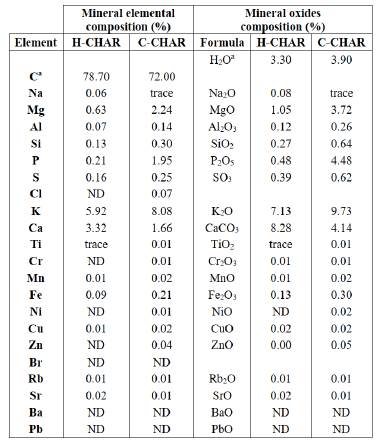
H2Oa and Ca from TGA analysis; ND: not detected (<0.01%).
FTIR is a more widely used technique for functional groups analysis. The application of FTIR for bio-char stability analysis is based on the analysis of the carbon chemical functional groups.
The FTIR spectra are depicted in Figure 5. The spectra for H-CHAR (Figure 5A) and C-CHAR (Figure 5B) are similar both in shapes and intensities.
C-CHAR spectrum (Figure 5B) reveal bands located at 1623 cm-1 corresponding to quinones, belonging to carbonyl functionalities [34], bands located at 1056 and 1008 cm-1 related to phenolic groups [34], and several peaks between 880-700 cm-1 attributed to aromatic C-H and alcohol -OH out of plane bend [35]. H-CHAR (Figure 5A) has peaks between1500-1560 cm-1 corresponding with N-H functionalities [34], 1050 cm-1 (phenolic groups) and several peaks among 870-650 cm-1 (aromatic C-H and alcohol -OH out of plane bend) [35]. The oxygen and nitrogen surface functionalities found in the bio-chars can act as binding sites for metals adsorption through stable complexes formation [36, 37]. This could improve their performance as amendment on contaminated soils with metals.
General remarks
Coffee and cocoa seed husk of the eastern region of Cuba constitute a promising product. These biomass waste will be increased for 2021. According with our results this waste should be used in three main activities. First, as energy suppliers through waste conversion, second as soil amendment to improve the nutrient availability and third as raw material to produce bio-char. The conversion of coffee and cocoa seed husks into added value products through slow pyrolysis process will help clean the environment, decrease the greenhouse effect, and will aid farmers in the rural populations by providing them with an additional source of income.
Conclusions
The yield and the theoretical energy production of bio-char, bio-oil and gas obtained by slow pyrolysis shown the possibility of conversions of coffee and cocoa seed husk into these value products. Coffee husks are more suitable for the production of gas, meanwhile cocoa seed husk for bio-oil, with theoretical energy potential estimated at 8291 MWh for the coffee husks and 1384 MWh for the cocoa seed husks. According to the calculated energy potential per year these products should be used as energy suppliers in the future. Characterization of bio-char indicates high contents of carbon, calcium, potassium, nitrogen and oxygen, making it an ideal candidate for its use as soil amendment. Nevertheless, results obtained here also shown that bio-chars obtained from different raw materials have different composition and could help us to understand their impact for different uses in the future.













